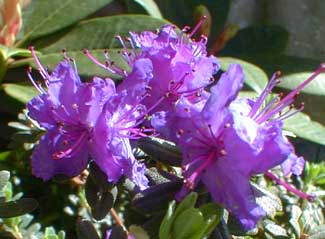
Dwarf Purple Rhododendron;
or, Cloudland Rhododendron
"I slunk into the bush for rest,
And found my fairy kin."
-John Le Gay Brereton
(1871-1933)
(1871-1933)
Rhododendron impeditum is a mounding or cushion-shaped dwarf rhododendron with tiny leaves as well as a small stature. A mature specimen is a foot tall if that, & as much as two feet wide.
A great many of the species rhodies from Yunnan China have violet to purple flowers, but this one is a stand-out even though within the common color range, both for its eency aromatic silvery grey-green leaves, & for a more intensely purple flower than is typical of the other Yunnan species.
It can be so flowery that the shrub becomes a pure mound of purple for at least three weeks around April or May, but stressed specimens will have only a few flowers over a densely leafed mound.
There are two specimens in our friends' garden that I've helped care for. Both were in locations too shaded & too dry, so they were only moderately flowerful. The individual who planted them in less than ideal circumstances didn't know they were so fussy, & I eventually dug them up to transplant into a more ideal spot with other dwarf rhodies, where I was trying to create the appearance of evergreen groundcover with several small cultivars.
Its common name Cloudland Rhododendron is a literal translation of its name in Chinese, a name which alludes to its alpine habitat. It thrives in moist cool temperatures & will not thrive above Zone 8. It requires some protection against desicating winter winds & from the harshest summer sunlight, though it is otherwise a sun-lover.
It rarely needs pruning as it holds its formal shape without assistance. If it is pruned, note that it is especially easy to root new shrubs from the cuttings. If it does demand pruning to remove dead wood or leafless limbs, reassess its growing conditions, as it may need more protection from winter winds & summer heat; or it may be in too much shade; or it may not be getting the amount of water it requires.
It was introduced to western gardening in 1911 by plant explorer George Forrest (1873-1932). Although pure species-rhodies seem in the main to be a specialized interest, with the plebian hordes preferring hybrids, R. impeditum is a mass-market offering, very easy to obtain.
Many dwarf cultivars are derived from this species, including 'Oceanlake' & the early-flowering cultivar 'Karin Seleger' which share R. impeditum's sensitivity to heat & drought. But the wild form is also a very common offering that takes very little effort to track down.
Since it is not drought tolerant, the root system may require a bit of woodchip mulch in summer both to retain moisture for the root & to protect the root from overheating.
The American Rhododendron Society Massachusetts Chapter places it on their provisionally recommended list of rhododendrons, recognizing that it can be fussy compared to the hardiest of hardy rhodies. But any specimen that suffers no winter damage or summer exhaustion its first two years in the ground should be hardy thereafter, though more than with most commonly gardened rhodies, it will forever be at risk in a dry summer heatwave.
It can especially be delicate its first year in the ground, because they are not usually hardened off before marketed & are not used to being outside. It wants full sun either morning or afternoon, but during that first year settling in it can be susceptible to sunburn, struggle in droughtiness, or die from excess wetness. Suffering specimens can drop a lot of the little leaves, or the leaves can die on the branches, or individual branches can die so that the shrub needs trimming back to living wood & takes a long time growing back.
So it may need a little babying at first in order to retain its good looks that first year. But when it is nicely settled in after that first year or year & a half, it will become a tough low-maintenance little shrub, flowering profusely for spring, & its wee greyish-green leaves turning mahagony or plum colored for winter. Many specimens will occasionally produce a few out-of-season flowers, even in autumn or winter.